Software > OpenVMS Systems > Documentation > 731final > 6552 HP OpenVMS Systems Documentation |
Compaq Availability Manager User's Guide
2.5 Getting HelpTo obtain online help, click the Help menu on the Application window menu bar. Then choose one of the following options:
Chapter 3
|
Before you start this chapter, be sure to read the explanation of data collection, events, thresholds, and occurrences in Chapter 1. Compaq also recommends completing the getting-started steps described in Chapter 2. |
Node summary data is the only data that is collected by default. The Availability Manager looks for events only in data that is being collected.
You can collect additional data in either of the following ways:
Refer to Chapter 1 and Chapter 7 for details.
This chapter describes the node data that the Availability Manager displays by default and more detailed data that you can choose to display. Differences are noted whenever information displayed for OpenVMS nodes differs from that displayed for Windows nodes.
Although Cluster Summary is one of the tabs displayed on the OpenVMS Node Summary page (see Figure 3-3), see Chapter 4 for a detailed discussion of OpenVMS Cluster data.
Figure 3-1 OpenVMS Node Pane
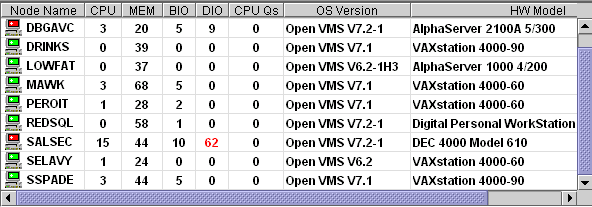
The following sections describe the data displayed for OpenVMS and Windows Node panes.
Refer to Section 7.5 for information about setting event thresholds. Appendix B describes OpenVMS and Windows events.
| Data | Description of Data | Related Event |
|---|---|---|
| Node Name | Name of the node being monitored. | n/a |
| CPU | Percentage of CPU usage of all processes on the node. | n/a |
| MEM | Percentage of space in memory that all processes on the node use. | LOMEMY |
| BIO | Buffered I/O rate of processes on the node. | HIBIOR |
| DIO | Direct I/O usage of processes on the node. | HIDIOR |
| CPU Qs | Number of processes in one of the following states: MWAIT, COLPG, PFW, FPG. | n/a |
| OS Version | Version of the operating system on the node. | n/a |
| Hardware Model | Hardware model of the node. | n/a |
Figure 3-2 is an example of a Windows Node pane. From the group you select, the Availability Manager displays all the nodes with which it can communicate.
Figure 3-2 Windows Node Pane

For each Windows node in the group, the Availability Manager displays the data shown in Table 3-2.
| Data | Description |
|---|---|
| Node Name | Name of the node being monitored. |
| CPU | Percentage of CPU usage of all the processes on the node. |
| MEM | Percentage of memory that is in use. |
| DIO | Direct I/O usage of processes on the node. |
| Processes | Number of processes on the node. |
| Threads | Number of threads on the node. A thread is a basic executable entity that can execute instructions in a processor. |
| Events | The number of events on the node. An event is used when two or more threads want to synchronize execution. |
| Semaphores | The number of semaphores on the node. Threads use semaphores to control access to data structures that they share with other threads. |
| Mutexes | The number of mutexes on the node. Threads use mutexes to ensure that only one thread executes a section of code at a time. |
| Sections | The number of sections on the node. A section is a portion of virtual memory created by a process for storing data. A process can share sections with other processes. |
| OS Version | Version of the operating system on the node. |
| HW Model | Hardware model of the node. |
The following sections describe node data pages, which you can display in any of the following ways:
The menu bar on each node data page contains the options described in Table 3-3.
| Menu Option | Description | For More Information |
|---|---|---|
| File | Contains the Close option, which you can choose to exit from the pages. | n/a |
| View | Contains options that allow you to view data from another perspective. | See specific pages. |
| Fix | Contains options that allow you to resolve various resource availability problems and improve system performance. | Chapter 6 |
| Customize | Contains options that allow you to organize data collection and analysis and to display data by filtering and customizing Availability Manager data. | Chapter 7 |
The following sections describe individual node data pages.
Figure 3-3 Node Summary Page
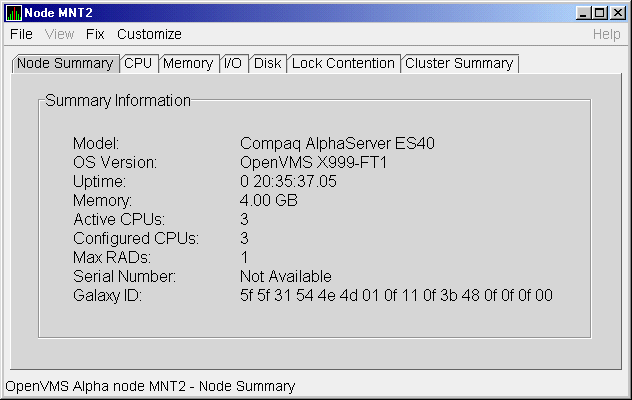
On this page, the following information is displayed for the node selected:
| Data | Description |
|---|---|
| Model | System hardware model name. |
| OS Version | Name and version of the operating system. |
| Uptime | Time (in days, hours, minutes, and seconds) since the last reboot. |
| Memory | Total amount of physical memory (in megabytes) found on the system. |
| CPUs | Number of active CPUs on the node. |
By clicking the CPU tab, you can display CPU panes that contain more detailed statistics about CPU mode usage and process summaries than the Node Summary does. You can use the CPU panes to diagnose issues that CPU-intensive users or CPU bottlenecks might cause. For OpenVMS nodes, you can also display information about specific CPU processes.
When you double-click a value under the CPU or CPU Qs heading on either an OpenVMS or a Windows Node pane, or when you click the CPU tab, the Availability Manager displays the CPU Modes Summary in the top pane and, by default in the bottom pane, CPU Modes Detail. You can use the View menu to select the CPU Process Summary in the bottom pane (see Section 3.2.2.4).
CPU modes summaries and process summary panes are described in the following sections. Note that there are differences between the pages displayed for OpenVMS and Windows nodes.
Figure 3-4 Windows CPU Modes Page
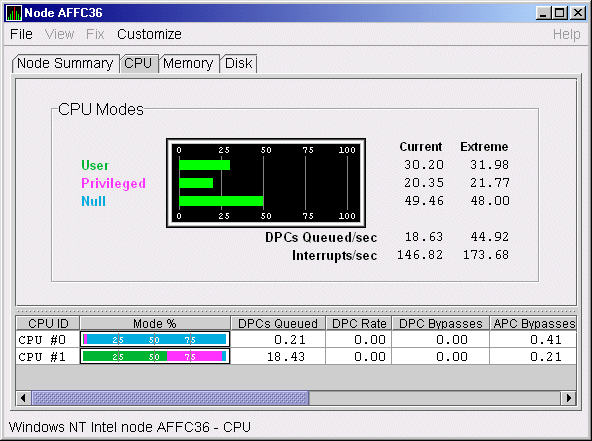
The top pane of the Windows CPU Modes page is a summary of Windows CPU usage, listed by type of mode.
On the left, the following CPU modes are listed:
On the graph, values that exceed thresholds are displayed in red. To the right of the graph are current and extreme amounts for each mode.
Current and extreme amounts are also displayed for the following values:
The bottom pane of the Windows CPU Modes contains modes details. The following data is displayed:
Figure 3-5 shows a sample OpenVMS CPU Modes summary, which is the top pane of the CPU Modes page.
Figure 3-5 OpenVMS CPU Modes Summary Pane
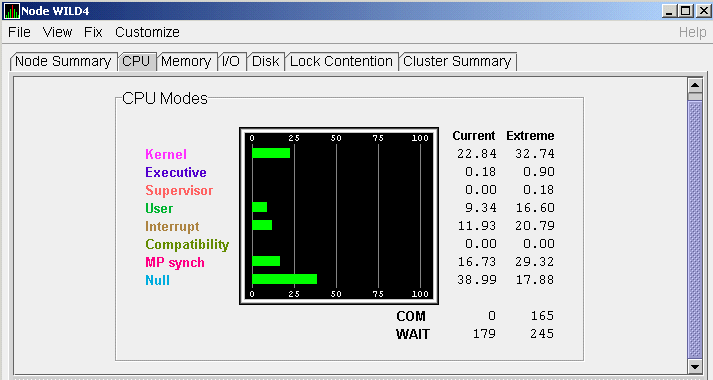
The CPU Modes summary pane shows OpenVMS CPU usage by mode. On symmetric multiprocessing (SMP) nodes, percentages are averaged across all the CPUs and are displayed as a single value.
To the left of the graph is a list of CPU modes. The bars in the graph represent the percentage of CPU cycles used for each mode. Values that are lower than the thresholds are displayed in green; values that exceed thresholds are displayed in red. To the right of the graph are current and extreme percentages of time spent in each mode.
Below the graph, the Availability Manager displays the COM and WAIT process queues:
See Appendix A for explanations of CPU process states.
Figure 3-6 OpenVMS CPU Modes Detail Pane

In the OpenVMS CPU Modes Detail pane, the following data is displayed:
| Data | Description |
|---|---|
| CPU ID | Decimal value representing the identity of a processor in a multiprocessing system. On a uniprocessor, this value is always CPU #00. |
| State | One of the following CPU states: Boot, Booted, Init, Rejected, Reserved, Run, Stopped, Stopping, or Timeout. |
| Mode % | Graphical representation of the percentage of active modes on that CPU. The color displayed coincides with the mode color in the graph in the top pane. |
| PID | Process identifier (PID) value of the process that is using the CPU. If the PID is unknown to the console application, the internal PID (IPID) is listed. |
| Process Name | Name of the process active on the CPU. If no active process is found on the CPU, the name is listed as *** None ***. |
| Capabilities | One or more of the following CPU capabilities: Primary, Quorum, Run, or Vector. |
| RAD | Number of the RAD where the CPU exists. |
Figure 3-7 OpenVMS CPU Process Summary Pane

The OpenVMS CPU Process Summary pane displays the following data:
| Data | Description |
|---|---|
| PID | Process identifier, a 32-bit value that uniquely identifies a process. |
| Process Name | Name of the process active on the CPU. |
| Priority | Computable (xx) and base (yy) process priority in the format xx/yy. |
| State | One of the process states listed in Appendix A. |
| Rate | Percentage of CPU time used by this process. This is the ratio of CPU time to elapsed time. The CPU rate is also displayed in the bar graph. |
| Wait | Percentage of time the process is in the COM or COMO state. |
| Time | Amount of actual CPU time charged to the process. |
| Home RAD | Where most of the resources of the process reside. |
Displaying Single Process Information
When you double-click a PID on the lower part of an OpenVMS CPU Process Summary (Figure 3-7), Memory Summary (Figure 3-9), or I/O Summary (Figure 3-11) page, the Availability Manager displays the first of several OpenVMS Single Process pages. On these pages, you can click tabs to display specific data about one process.
This data includes a combination of data elements from the CPU Process, Memory, and I/O pages, as well as data for specific quota utilization, current image, and queue wait time. These pages are described in more detail in Section 3.3.
The Availability Manager displays the Windows Memory page (Figure 3-8).
Figure 3-8 Windows Memory Page
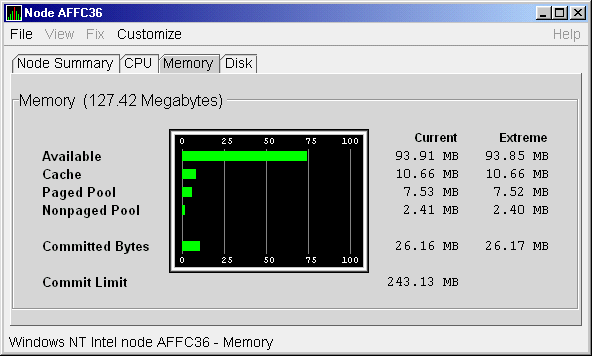
The Current and Extreme amounts on the page display the data shown in the following table. The table also indicates what the graph amounts represent.
When you double-click a value under the MEM heading in an OpenVMS Node pane, or if you click the Memory tab, the Availability Manager displays the OpenVMS Memory Summary page (Figure 3-9).
Alternatively, if you click the View menu on the OpenVMS Memory Summary page, the following options are displayed in a popup menu:
You can click Memory Summary View to select the Memory Summary page.
Figure 3-9 OpenVMS Memory Summary Page
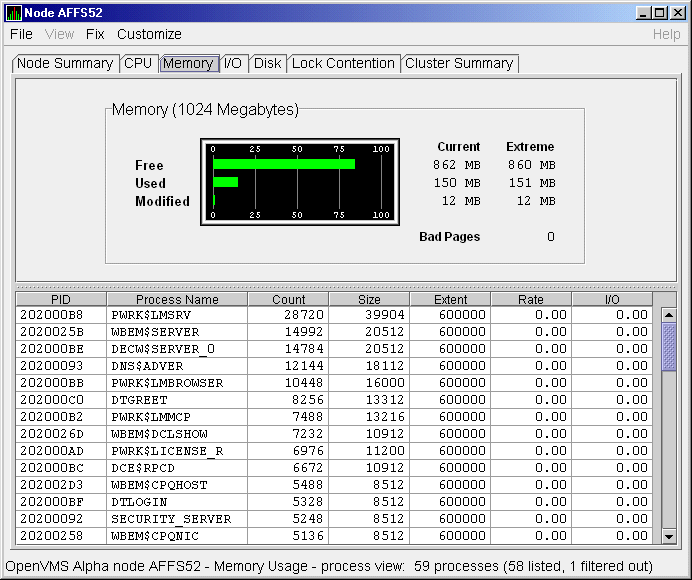
The graph in the top pane shows memory distribution (Free, Used, and Modified) as absolute values, in megabytes of memory. Current and extreme values are also listed for each type of memory distribution. (Free memory uses the lowest seen value as its extreme.) Bad Pages show the number of pages that the operating system has marked as bad. The thresholds that you see in the graph are the ones set for the LOMEMY event. (The LOMEMY thresholds are also in the display of values for the Mem field in the OpenVMS Node pane shown in Figure 3-1.)
The bottom pane displays the following data:
| Data | Description |
|---|---|
| PID | Process identifier. A 32-bit value that uniquely identifies a process. |
| Process Name | Name of the process. |
| Count | Number of physical pages or pagelets of memory that the process is using for the working set count. |
| Size | Number of pages or pagelets of memory the process is allowed to use for the working set size. The operating system periodically adjusts this value based on an analysis of page faults relative to CPU time used. |
| Extent | Number of pages or pagelets of memory in the process's working set extent (WSEXTENT) quota as defined in the user authorization file (UAF). Number of pages or pagelets cannot exceed the value of the system parameter WSMAX. |
| Rate | Number of page faults per second for the process. |
| I/O | Rate of I/O read attempts necessary to satisfy page faults (also known as page read I/O or the hard fault rate). |
When you double-click a PID on the lower part of the Memory Summary page (Figure 3-9), the Availability Manager displays an OpenVMS Single Process, where you can click tabs to display pages containing specific data about one process. This data includes a combination of data from the CPU Process, Memory, and I/O pages, as well as data for specific quota utilization, current image, and queue wait time. These pages are described in Section 3.3.
| Previous | Next | Contents | Index |